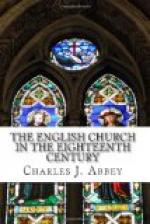Not, of course, that Horsley approved of the attempts made at the close of the second century to meet the Platonists half-way by professing that the leading doctrines of the Gospel were contained in Plato’s writings. He strongly condemned, e.g., the conceit of the Platonic Christians that the external display of the powers of the Son in the business of Creation is the thing intended in Scripture language under the figure of his generation. ‘There is no foundation,’ he thinks, ’in Holy Writ, and no authority in the opinions and doctrines of preceding ages. It betrayed some who were most wedded to it into the use of very improper language, as if a new relation between the First and Second Persons took place when the creative powers were first exerted.’ He condemns ’the indiscretion of presuming to affix a determinate meaning upon a figurative expression of which no particular exposition can be drawn safely from Holy Writ.’ ‘But,’ he adds, ’the conversion of an attribute into a person, whatever Dr. Priestley may imagine, is a notion to which they were entire strangers.’ On the main question of the Trinity he asserts, in opposition to Dr. Priestley, that they were quite sound.
Adopting the same line of argument which Leslie had used before him, Horsley dexterously turns the supposed resemblance between Platonism and Christianity, which, as has been seen, he admits, into a plain proof that the doctrine of the Trinity cannot be such a contradiction as the Unitarians represented it to be.
The controversy between Priestley and Horsley brings us nearly to the close of the eighteenth century. There had been a considerable secession of English clergymen to the Unitarians,[466] and Horsley’s masterly tracts were a very opportune defence of the Catholic doctrine. On one point he and his adversary thoroughly concurred—viz., that there could be no medium between making Christ a mere man and owning Him to be in the highest sense God. Arianism in its various forms had become by this time well-nigh obsolete in England. It was a happy thing for the Church that this point had been virtually settled. The alternative was now clearly set before English Churchmen—’Choose ye whom ye will serve; if Christ be God, follow him; if not, be prepared to give up all notions of a creature worship.’ The Unitarians at the close of the eighteenth century all took their stand on this issue. Such rhapsodies as those which were indulged in by early Socinians as well as Arians were now unheard. The line of demarcation was strictly drawn between those who did and those who did not believe in the true Godhead and distinct personality of the Second and Third Persons of the Blessed Trinity, so that from henceforth men might know on what ground they were standing.




